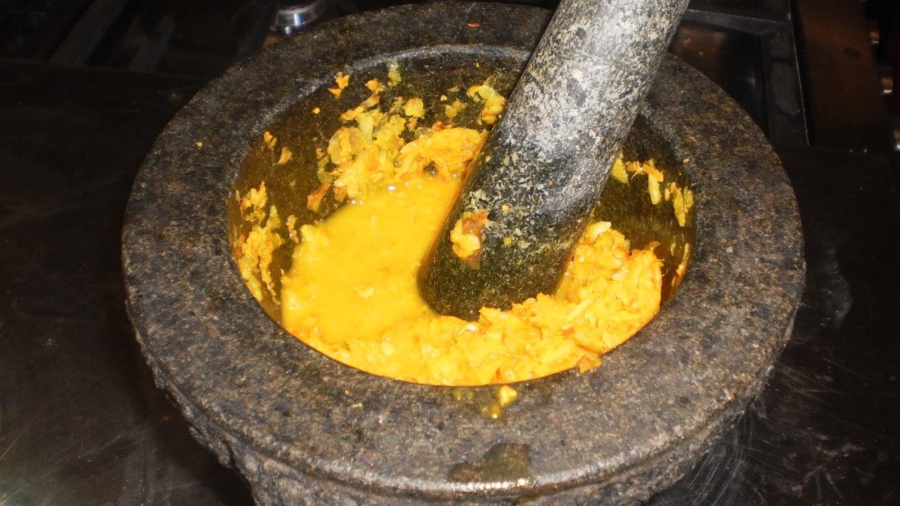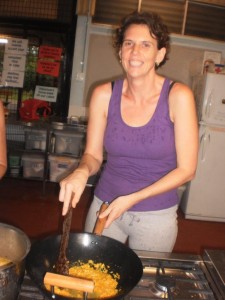Many years ago I started an initiative which I called the Community Chef. The idea was to share recipes using local food and a dozen of us would gather in someone’s house to prepare and cook these together. I remember the smell of garlic and ginger being pushed around the wok, the laughter of men gathered round the stove, the chatter of women munching on carrots and homemade spinach dips, and handwritten recipes handed down in families or along cultural storylines. There was something about this experience that was pretty darn special. Even though our community cooking nights have moved to an outdoor kitchen at my local community garden, this method of sharing knowledge and skills in such an earthy, organic way has huge therapeutic potential for each one of us. It does not assume that only one person is the expert but that we can all be teachers and learners.
It was pretty ironic that I would meet Natalie Rudland-Wood at around the same time as starting the Community Chef. Natalie had developed the Recipes of Life program, adapted from similar narrative folk cultural methodologies like the Tree of Life. Natalie was using Recipes to engage children and young people affected by homelessness in conversations about their lives using the metaphor of food. Cooking and counselling was proving to be an effective mix. In documenting and sharing their Recipes for overcoming hard times, the kids were experts in their own lives and becoming supportive mentors for their peers!
Having recently won a small grant, I’m currently preparing a program to trial Recipes of Life with refugees and asylum seekers living in Darwin. It is not my intention to describe how the program works, but instead give you “a taster” by sharing my own recently crafted Recipe of Life. Hopefully, you will see the two-fold potential therapeutic benefits, for the person writing their recipe and contributing it to the life of another, and the person receiving it (who might also be experiencing hard times).
LUCY’S RECIPE FOR LIVING WITH CHRONIC BACK PAIN
Ingredients
Mental strength one bucket
Support a cup overflowing
Mindfulness 1 shovel full
Stamina a heap
Willpower as much as you can muster
Good diet 1 teaspoon per day
Exercise between 1 teaspoon and 1 cup per week
Acceptance ideally 1 pinch per day
Patience 1 handful per day
Understanding doesn’t need to be added, just happens
Sourcing
The origins of Mental Strength are home grown after watching my mum who has had to put up with a lot over the years. I remember having it after leaving home and it grows stronger every year.
Support is ‘on loan’ from my generous husband and kind friends. It is always available but not always easy to accept.
The ideas and principles of Mindfulness have been imported over the years from friends, books, people I don’t know on the internet and Buddhist Monk, Gen Kelsang Dornying.
Stamina and Willpower is cultured from home as a result of leaving my birthplace and family in my early twenties and learning to rely on myself.
Good Diet and exercise are a mix of home grown skills of listening to my body mixed with advice from trusted naturopaths and chiropractors. This sometimes gets confusing as the two sources can be conflictual. But in the end, I know best, over any expert advice.
Acceptance is reluctantly borrowed from God who makes it easier to understand the need for this Recipe.
Patience is a gift from gentle role-models like my mum and Nelson Mandela.
Understanding is also a gift that presents itself from the mixing of all the other ingredients.
Method
Blend together mental strength and support using a wheelbarrow and shovel. Pack down tight into the bottom of the wheelbarrow so there are no gaps. You can’t afford to let any contaminants spoil this mix.
In a bowl, whisk together mindfulness, stamina and willpower. Set it aside to ferment. This will take a minimum of six months. Every day add good diet to the bowl. Once a week add in exercise, not too much, just the right balance (depending on how you feel). If it hurts, back off and just add the minimum required. Even though you don’t like it, you must add small amounts of Acceptance especially on bad days. For best results, add a pinch every day along with Patience. The fermenting process is complete when Understanding has developed. You are now ready to add this mix to the wheelbarrow.
Spread on top and leave out in the pure natural rays of the sun to cook. It will rise in the heat.
This recipe will take at least six months to ferment and develop its subtle flavour because you have to adjust ingredients as you go, depending on the level of pain on a given day. Full maturity may take as long as two years.
Mental Strength is the backbone of the recipe. Without it, the recipe is doomed.
NB: My special tip is on really bad days to consume double the dose. For example, for my peace of mind, I had to advocate strongly to get an MRI against doctor’s advice which was “not clinically indicated”. This takes a double dose of Mental Strength.
Serving Suggestion
Sometimes you will have to eat this in bed.
But the ideal way to serve it is at the end of the day, preferably in front of the sunset on the beach, surrounded by loved ones. I would have my immediate family, mum and close friends there, swaying in cosy hammocks with not a care in the world. The spread would be laid out on a huge picnic blanket with simple pure white crockery, the best silverware I could afford and fancy etched glasses with pink champagne. The picnic basket would never run out of food. We could eat as much as we wanted. There would be a high tide, lapping at our feet and a gentle breeze with the sweet smell of frangipani’s tickling my nose. The sound of curlews would ring out gently and intercept the laughter and joy of friendship. I would speak with gratitude in honour of my soul mate and husband for sticking by me “in sickness and in health” for 21 years and the support of all those since that have drifted through my life, sharing their knowledge, encouragement and love. A fairy would magically come and do all the washing up, leaving everything sparkly clean back in the picnic basket.
Has this got you thinking about how to use these ideas in your work?
Or perhaps how your personal Recipe could actually make a difference to the life of someone else?
Read more about Recipes of Life by downloading Natalie’s article in the International Journal of Narrative Therapy and Community Work or watch a video about her methodology. If you’d like to write your own Recipe, contact us.


